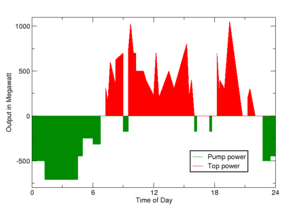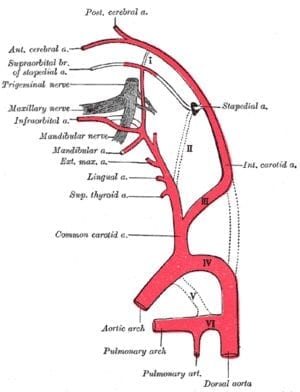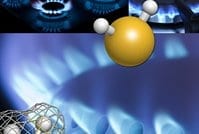
By skillfully combining the output of a number of solar, wind and biogas plants the grid can be provided with stable energy 24 hours a day without fear of blackouts
Critics of renewables have always claimed that sun and wind are only intermittent producers of electricity and need fossil fuel plants as back-up to make them viable. But German engineers have proved this is not so.
By skillfully combining the output of a number of solar, wind and biogas plants the grid can be provided with stable energy 24 hours a day without fear of blackouts, according to the Fraunhofer Institute for Wind Energy and Energy System Technology (IWES) in Kassel.
For Germany, which has turned its back on nuclear power and is investing heavily in all forms of renewables to reduce its carbon dioxide emissions, this is an important breakthrough.
The country has a demanding industrial sector that needs a large and stable electricity supply, and some doubted that this could be achieved in the long term without retaining nuclear or large fossil fuel plants.
Solving the problem is becoming urgent. The latest figures show that on some days of the year the electricity being generated from sun, wind, biomass, water and geothermal production already accounts for more than half of the load required in the country.
The research is funded by the German Federal Ministry of the Environment and is aimed at showing that the entire electricity grid could be run on renewable energy.
Dr. Kurt Rohrig, deputy director of IWES, said: “Each source of energy – be it wind, sun or biogas – has its strengths and weaknesses. If we manage to skillfully combine the different characteristics of the regenerative energies, we can ensure the power supply for Germany.”
The idea is that many small power plant operators can feed their electricity into the grid but act as a single power plant using computers to control the level of power (see our story of 20 January, Renewables: The 99.9% solution).
Sharing the load
Scientists linked together 25 plants with a nominal power output of 120 megawatts. Surplus power could be used for charging electric vehicles and for pumped storage (pumping water uphill into a reservoir to produce hydropower later).
When many small producers work together, then regional differences when the wind blows or the sun is intermittent are balanced out in the grid and can be boosted by controllable biogas facilities.
If there is too much surplus energy then the power can also be used to create and store thermal energy to be used later.
The Latest Bing News on:
Solution For Clean Energy
- CNNC provides nuclear energy solutions for global energy transitionon April 27, 2024 at 6:20 am
Photo: Courtesy of China National Nuclear Corporation "Currently, the world economy is gradually recovering, and the energy industry is accelerating its green and low-carbon trans ...
- Green Energy Expo 2024: Sungrow Unveils its Innovative Solar-Plus-Storage Solutions to Facilitate South Korea's Energy Transitionon April 26, 2024 at 7:47 am
Sungrow, the global leading PV inverter and energy storage system provider, showcased its cutting-edge solar-plus-storage solutions in the Green Energy Expo 2024. The solutions are designed to cater ...
- Inside the Fight for Truly “Squeaky Clean” Energy in New Jerseyon April 26, 2024 at 6:29 am
The main legislation in question (S237/A1480) would require that 100% of retail electricity sales in New Jersey come from “clean” sources by 2035. Lawmakers spent many months gathering input from ...
- Clean energy developer to transform former mine into massive clean energy storage project: 'Will help ensure people have energy when they need it'on April 26, 2024 at 3:15 am
The outlet compared the undertaking to a large battery-electric storage project but said: "Closed-loop pumped storage hydropower may be relatively more climate change friendly, at least according to ...
- Leaving the fumes behind: Bangladesh needs clean energy solutions for the transport sectoron April 25, 2024 at 8:37 pm
To achieve the goal of a sustainable and efficient mass transit network for Bangladesh, a proactive approach is required, supported by thorough policies and focused investments ...
- Advocates unveil new solutions to improve clean energy interconnectionon April 25, 2024 at 8:57 am
The report argues that new regional transmission planning processes should integrate data from the interconnection queues alongside demand and resource mix forecasts and regional clean energy goals.
- Climate Experts Say Clean Energy Shift Can and Must Lift Up Poorer Communitieson April 24, 2024 at 8:28 am
The Time100 Summit panel touched on how poorer communities like Houston's chemical quarter can benefit from the clean energy shift.
- Biden’s ‘Solar for All’ awards $7B to bring affordable energy to low-income familieson April 23, 2024 at 8:46 am
The program will provide money to 60 organizations to finance new and existing residential solar programs in low-income communities.
- Progress Toward A Clean Energy Transitionon April 19, 2024 at 12:24 pm
Global temperature increases are slowing, electric vehicle sales are growing, and renewable energy is now cheaper than some fossil fuels.
- A clean energy future is within our reachon April 17, 2024 at 4:18 pm
A healthy future for our children and grandchildren depends on progress towards net-zero carbon emissions and a swift transition to clean energy.
The Latest Google Headlines on:
Solution For Clean Energy
[google_news title=”” keyword=”Solution For Clean Energy” num_posts=”10″ blurb_length=”0″ show_thumb=”left”] [/vc_column_text]The Latest Bing News on:
Clean energy solution
- Catalyst Watch: This Beaten-Down, High-Yield Dividend Stock Is Working on a Long-Term Solution to Its Biggest Issueon April 27, 2024 at 6:36 am
NextEra Energy Partners is working to address the looming buyouts of its remaining convertible equity portfolio financing.
- Is Bloom Energy Stock a Buy?on April 27, 2024 at 12:12 am
The Bloom Energy Server uses its proprietary solid oxide technology to convert fuel (natural gas, biogas, hydrogen) through an electrochemical process without combustion. These servers can be ...
- Innovative Financing Needed To Boost Renewable Energy Solutions: IREDA Chiefon April 26, 2024 at 12:18 pm
( MENAFN - KNN India) New Delhi, Apr 26 (KNN) The Chairperson and Managing Director (CMD) of Indian Renewable Energy Development Agency Ltd. (IREDA) has underscored the need for innovative financing ...
- Rivers are the West’s largest source of clean energy. What happens when drought strikes?on April 26, 2024 at 1:15 am
With rivers across the West running low, electric utilities must get creative if they are to meet demand without increasing emissions.
- Advocates unveil new solutions to improve clean energy interconnectionon April 25, 2024 at 8:57 am
The report argues that new regional transmission planning processes should integrate data from the interconnection queues alongside demand and resource mix forecasts and regional clean energy goals.
- How to Find and Choose a Renewable Energy Supplier for Your Homeon April 25, 2024 at 5:01 am
In states with deregulated energy markets, finding a renewable energy supplier is fairly simple. The nuts and bolts of those plans are not.
- CMD IREDA proposes innovative financing solutions for emerging renewable energy technologieson April 25, 2024 at 1:12 am
Speaking at the 26th World Energy Congress in Rotterdam, Netherlands, Das emphasized the need for strategic investment to accelerate India’s energy transition towards renewable sources.
- The Preschool Solution To The Energy Transitionon April 24, 2024 at 10:09 am
We would have already solved climate change if we practiced what we teach our preschoolers: “Playing together starts with sharing together.” ...
- Gen Z Will Thrive on Clean-Energy Jobs. The Climate Corps Promises to Start Their Careerson April 22, 2024 at 1:32 pm
The growth of renewable energy and climate tech is helping Gen Z find stability in this economy. This Earth Day, President Biden's new climate program offering training and jobs has opened for ...
- Energy's New Wave: Meet 4 Women Powering America's Clean Energy Transitionon April 22, 2024 at 6:12 am
They're all under 30, and they've got a clear vision and the right skills to guide the US as it embraces the clean energy revolution.
The Latest Google Headlines on:
Clean energy solution
[google_news title=”” keyword=”clean energy solution” num_posts=”10″ blurb_length=”0″ show_thumb=”left”]










